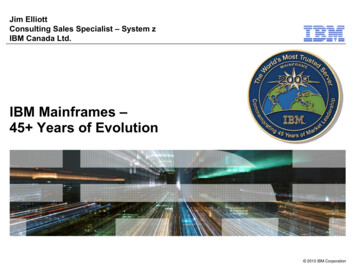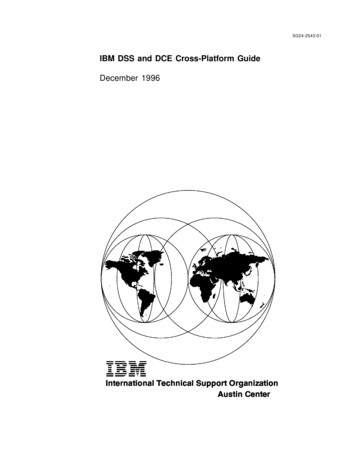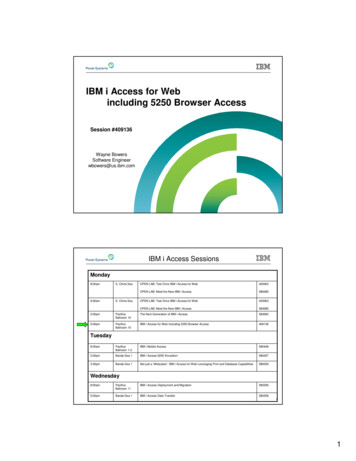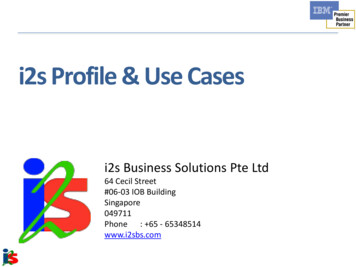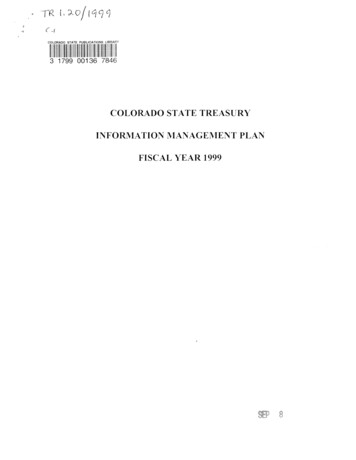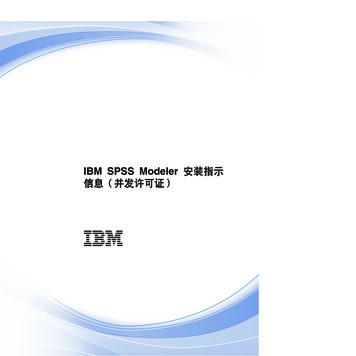
Transcription
IBMHistory and Evolution ofIBM MainframesJim ElliottAdvocate – Infrastructure SolutionsManager – IBM System z9 and zSeries Operating SystemsIBM Canada Ltd.ibm.com/vm/devpages/jelliottSHARE 105 Session 50072005-08-25 2005 IBM Corporation
IBMHistory and Evolution of IBM Mainframes The history of SHARE has paralleled that of IBM mainframes forover 50 years. This presentation will cover the history of IBMmainframes from the IBM 701 through IBM S/360 to IBM eServerzSeries and the new IBM System z9. The evolution of OS/360 toz/OS and CP/67 to z/VM will also be covered (with honorablemention of DOS/360 to z/VSE and ACP to z/TCP). The speaker has worked for IBM for over 32 years including stintsas an MVT, VM/370 and DOS/VS systems programmer, IMSapplication developer and product manager for VM, VSE and Linuxfor IBM Americas. Today Jim is responsible for all the System z9and zSeries operating systems in addition to being the Advocatefor Infrastructure Solutions for IBM Canada. As a result, he has'hands-on' experience with most of IBM's mainframes over thatperiod.2SHARE 105 Session 50072005-08-25
IBMReports of the death of themainframe were premature “I predict that the lastmainframe will be unpluggedon March 15, 1996.”– Stewart Alsop, March 1991 “It’s clear that corporatecustomers still like to havecentrally controlled, verypredictable, reliablecomputing systems – exactlythe kind of systems that IBMspecializes in.”– Stewart Alsop, February 2002Source: IBM Annual Report 20013SHARE 105 Session 50072005-08-25
IBMIn the Beginning – The First Two GenerationsSHARE 105 Session 50072005-08-25 2005 IBM Corporation
IBMThe family tree – 1952 to 1964 Several mainframefamilies announced,designed for differentapplications Every family had adifferent, incompatiblearchitecture Within families, movingfrom one generation to thenext was a migration– Common compilers mademigration easier – COBOLand FORTRAN5SHARE 105 Session 50072005-08-25
IBMIBM 701 – 19521st generation The first IBM large-scale electronic computermanufactured in quantity IBM's first commercially available scientific computer The first IBM machine in which programs were storedin an internal, addressable,electronic memory The first of the pioneeringline of IBM 700 seriescomputers, including the702, 704, 705 and 7097016SHARE 105 Session 50072005-08-25
IBMIBM 305 RAMAC – 19561st generation The first computer to include a disk drive (named theIBM 350 Disk File) Prior to this magnetic computer storage had consistedof core memory, tape, and drums The 350 Disk File consisted of a stackof fifty 24” discs350 Disk The capacity of the entire diskfile was 5 million 7-bit characters,which works out to about 4.4 MBin modern parlance7SHARE 105 Session 50072005-08-25
IBMIBM 1401 – 19592nd generation The all-transistorized IBM 1401 Data Processing Systemplaced the features found in electronic data processingsystems at the disposal of140214011403smaller businesses,previously limited to the useof conventional punchedcard equipment These features included: highspeed card punching andreading, magnetic tape inputand output, high speedprinting, stored program, andarithmetic and logical ability8SHARE 105 Session 50072005-08-25729
IBMIBM 1440 – 19622nd generation Low-cost system specifically designed to solve theincreasing data handling problems of smaller volumebusinesses14431441 The 1440 met the need for acomplete accounting systemand offered the benefits of abusiness information system With a variety of models andspecial features available forthe 1440, a system could betailored to meet immediatedata processing requirementsand expanded to absorbincreased demands9SHARE 105 Session 50072005-08-251311
IBMIBM 7094 – 19622nd generation Built for large-scale scientific computing Compatible with the IBM 7090, the advanced solid-stateIBM 7094 offered substantial increasesin internal operating7094speeds and functionalcapacities New expanded functionsprovided with the IBM 7094were: double-precisionfloating-point operationsand seven index registers10SHARE 105 Session 50072005-08-25
IBMThe April 1964 Revolution –3rd generationSHARE 105 Session 50072005-08-25 2005 IBM Corporation
IBMDuring the 1950s, Data Processing came of age Data Processing machines existed – sorters, collators,tabulators "Computers" were devoted almost entirely to theprocessing of computationally intensive tasks Demand for computers, as data processing machines,boomed and new machines were built to meet thisdemand Customers were getting very frustrated with migrationcosts that came with processor upgrades12SHARE 105 Session 50072005-08-25
IBM13SHARE 105 Session 50072005-08-25
IBMSystem/360 – Announced April 7, 1964 IBM decided to implement a wholly new architecturespecifically designed both for data processing and to becompatible across a wide range of performance levels IBM invested 5B to develop a family of fiveincreasingly powerful computers that run the sameS/360-75operating systems and can usethe same 44 peripheral deviceswith the same architecture– Architecture published in theS/360 Principles of Operation– 24-bit addressing (32-bit architecture)– Solid logic circuit cards240114SHARE 105 Session 50072005-08-252311
IBMSystem/360 – a child is born Hardware– One main storage, maximum size is 16MB– One or two Central Processing Units (CPUs)– One to seven Channels– Selector or Byte Multiplexor– Block Multiplexor– Control Units (which connect to Channels)– Devices (which connect to Control Units) Family of operating systems– Operating System/360 (OS/360)– Disk Operating System/360 (DOS/360)– TOS, BPS, – ACP15SHARE 105 Session 50072005-08-25
IBMCoreMemory16SHARE 105 Session 50072005-08-25
IBMS/360 family17ModelAnnouncedFirst Shipped30April 7, 1964June, 196540April 7, 1964April, 196550April 7, 1964August, 196520*November 18, 1964April, 196665April 22, 1965November, 196575April 22, 1965January, 196644August 16, 1965June, 196667August 16, 1965May, 196691January 18, 1966October, 196725January 3, 1968October, 196885January 30, 1968December, 1969195August 20, 1969March, 1971SHARE 105 Session 50072005-08-25Virtual storageHigh speed cache
IBMSystem/360 Model 201966 Special purpose“entry level” S/360 24K of corememory Half the registers ofother models Instruction set thatwas not binarycompatible with therest of the S/360family Popular as an RJEworkstation18SHARE 105 Session 50072005-08-25
IBMSystem/360 Model 67 First IBM system with virtual storage capabilities– S/360 Model 65 with addition of the Dynamic AddressTranslation facilityS/360-67 Operating systems– Time Sharing System –The “official” operating systemfrom IBM Data Systems Division– Control Program/67 with theCambridge Monitor System –The “unofficial” operating systemfrom the IBM Cambridge ScientificCenter“DAT box”University of Newcastle Upon Tyne19SHARE 105 Session 50072005-08-25
IBMSystem/370 – Announced June 30, 1970 Compatible upgrade from S/360 370 Model 145 is the first computer with fully integratedmonolithic memory (circuits in which all of the sameelements – resistors, capacitors and diodes – arefabricated on a single slice of silicon) and 128-bit bipolar chips"We are confident that the performanceof System/370, its compatibility, its New peripherals– 3330/3340/3350 disk– 3211 printerengineering and its programming willmake it stand out as the landmark forthe 1970s that System/360 was for theSixties."Tom Watson, Jr.IBM Chairman and CEO1961-197120SHARE 105 Session 50072005-08-25
IBMSystem/370 with Virtual Storage –Announced August 2, 1972 Compatible upgrade from S/370 with virtual storage First multiprocessormodels (158MP, 168MP) Family of operating systems 38503705S/370-148– OS/360 Î OS/VS– DOS/360 Î DOS/VS– CP/67 Î VM/370350521SHARE 105 Session 50072005-08-253203352533503270
IBMS/370 – the architecture matures Virtual storage– 2KB or 4KB pages of memory– 64KB or 1MB segment sizes– Translation of virtualaddresses to real addressesusing Dynamic AddressTranslation (DAT) logic– Segment tables point to pagelocations30333031 Channel architecture– 256 channels CPU changes– Extended MP support viaCPU address22SHARE 105 Session 50072005-08-25
IBMS/370 irst ShippedReplacement155June 30, 1970January, 1971158165June 30, 1970April, 1971168195June 30, 1970August, 1973145September 23, 1970June, 1971148135March 8, 1971April, 1972138158August 2, 1972April, 19733031168August 2, 1972May, 19733033125October 4, 1972April, 19734331/4361115March 13, 1973March, 19744331/4361138June 30, 1976November, 19764341/4381148June 30, 1976January, 19774341/4381SHARE 105 Session 50072005-08-25
IBMSystem/370 with Extended Architecture Evolution of S/370 3081 introduced ThermalConduction Modules New peripherals3083– 3800 printer– 3370/3380 disk– 3480 tape Family of operating systems– OS/VS Î MVS/SP Î MVS/XA– DOS/VS Î VSE/SP– VM/370 Î VM/SP, VM/SP HPO– VM/370 Î VM/XA MA Î VM/XA SF Î VM/XA SP24SHARE 105 Session 50072005-08-25
IBM370-XA – radical surgery for the architecture Extended storage addressing– 24-bit or 31-bit addressing– 4KB pages in 1MB segments Interpretive execution facility– Start Interpretive Execution (SIE) instruction– SIE runs until interception condition raised– Used by VM/XA– Multiple High Performance Guest Support Facility (MHPGSF)to support V F guests on VM/XA SP Rename Processor Resource/Systems Manager (PR/SM) whenLogical Partitions (LPAR) announced 370-XA channel design– CHPIDs– Subchannels25SHARE 105 Session 50072005-08-25
IBMSystem/370 with Enterprise SystemsArchitecture Extension of 370-XA– Expanded Storage– Multiple 31-bit address spaces Common set of peripheral devices– 3390 disk– 3490 tape3090 Family of operating systems– MVS/XA Î MVS/ESA– VSE/SP Î VSE/ESA– VM/XA SP Î VM/ESA26SHARE 105 Session 50072005-08-25
IBMSystem/390 with Enterprise SystemsArchitecture – Announced September 19909672-G5 Evolution of ESA/370 1994 – S/390 Parallel Transaction Server– Family of CMOS processors 1998 – System/390 Generation 5 server – more than 1,000 MIPS 1999 – System/390 Generation 6 server – copper chip technology Common set of peripheral devices– RAMAC, Enterprise Storage Subsystem disk– 3590 Magstar tapeES/9000 Family of operating systems– MVS/ESA Î OS/390– VSE/ESA– VM/ESA– Linux for S/390 (December 1999)27SHARE 105 Session 50072005-08-25
IBMS/370 to ES/900028115/125138/148158/168 4331 Î 432143413031/3032/3033 436143813081/3083/3084 upgrade 93704381-E3090 upgrade upgrade922191219021SHARE 105 Session 50072005-08-25
IBMParallel Transaction Server to G61994-04-069672-Enn,9672-PnnParallel Transaction Server1994-09-139672-Rn1Parallel Enterprise 4G31996-09-102003Multiprise 9-207060Multiprise 30001999-05-039672-nn7G629SHARE 105 Session 50072005-08-25
IBMzSeries with z/Architecture –Announced October 2000 Evolution of ESA-390zSeries 900– 24-bit, 31-bit, and 64-bit addressingsupported concurrently– z900 – up to 16 processors– z800 – up to 4 processors Linux-only model in January 2002 General purpose model in February 2002– Integrated Facility for Linux on z900/z890 Family of operating systems– OS/390 Î z/OS– VSE/ESA Î z/VSE– VM/ESA Î z/VM– TPF Î z/TPF– Linux for S/390 Î Linux for zSeries30SHARE 105 Session 50072005-08-25
IBMzSeries Enhanced May 2003– z990 – up to 32 processors – configurable as CPs, IFLs, SAPs– Up to 256GB memory October 2003zSeries 990– The Mainframe Charter April 2004– z890 – up to 4 configurable processors– zSeries Application Assist Processor October 2004– Crypto Express 2 January 2005– FICON Express 231SHARE 105 Session 50072005-08-25
IBMSystem z9 – Announced July 26, 2005 IBM System z9 109 (z9-109) delivers excellence in large scaleenterprise computing and is designed and optimizedas the hub of the on demand enterprise Built on more than 40 years as an industry-acknowledgedleader and taking that leadership to new levels– Scalability– Availability and security– Balanced system design– Virtualization technology Breaking new ground– Designed to minimize outages to helpyour business stay always on– Greater scalability and performance togrow with your business– Flexibility to enable efficient responseto your business needs32SHARE 105 Session 50072005-08-25
IBMSystem z9 and zSeries: Balanced System DesignSystem I/O BandwidthBalanced SystemCPU, n-way, memory,I/O bandwidth*172.8 GB/sec96 GB/sec24 GB/secGBs512 GB256 GB64 GB288.15450 60012-way16-way32-waySystem z9 109*zSeries 99054-wayzSeries 900Generation 6CPUsGeneration 5*z9-109 exploits a subset of its designed I/O capability33SHARE 105 Session 50072005-08-25MIPs for1-way
IBM9672-G5 to eServer zSeries to System 199672-nn69672-nn72064-1nn2064-2Cn20662003-05-13 20842004-04-07 20862005-07-26 209434SHARE 105 Session 5007G5G6z900z900 Turboz800(Linux only model 2002-01-29)z990z890System z9 1092005-08-25
IBMApril 7, 2004 – The 40th Anniversary!SHARE 105 Session 50072005-08-25 2005 IBM Corporation
IBMApril 7, 2004 – The 40th e/36SHARE 105 Session 50072005-08-25
IBMSummary From System/360 in 1964 to today’s System z9 andzSeries, we have seen an evolution that has preservedcustomer investments in a unique way From OS/360 to MVS to OS/390 to z/OS, we have seenan evolution of the operating system that is core tomost corporate IT environments From CP/67 as a research project and VM/370 as amigration tool, VM has evolved to today’s z/VM as thecore of IBM’s zSeries virtualization technology– Virtualization is now considered “standard” in the industry andall virtualization solutions owe much to the VM family“Legacy systems are systems that work!”37SHARE 105 Session 50072005-08-25
IBMBibliography Melinda Varian, Princeton– “VM and the VM Community: Past, Present, and Future” presented at SHARE89, 1997 Jeff Gribbin, EDS UK– “Development of 360/370 Architecture – A Plain Man’s View”, 1989 Chuck Boyer– “The 360 Revolution”, 2004 IBM Archives: Valuable resources on IBM's history– http://www.ibm.com/ibm/history/ IBM Systems Journal– “VM/370–a study of multiplicity and usefulness”L H Seawright and R A MacKinnon, Volume 18, Number 1, 1979– Evolution of a virtual machine subsystemE C Hendricks and T C Hartmann, Volume 18, Number 1, 1979– “ESA/390 interpretive-execution architecture, foundation for VM/ESA”D L Osisek, K M Jackson, and P H Gum, Volume 30, Number 1, 1991 IBM Journal of Research and Development– “The Origin of the VM/370 Time-Sharing System”R J Creasy, Volume 25, Number 5, 198138SHARE 105 Session 50072005-08-25
IBMNotices Copyright IBM Corporation 2000, 2005. All rights reserved.This document contains words and/or phrases that are trademarks or registered trademarks of the International BusinessMachines Corporation in the United States and/or other countries. For information on IBM trademarks go tohttp://www.ibm.com/legal/copytrade.shtml.The following are trademarks or registered trademarks of other companies.– Java and all Java-related trademarks and logos are trademarks of Sun Microsystems, Inc., in the United States and other countries.– UNIX is a registered trademark of The Open Group in the United States and other countries.– Microsoft, Windows and Windows NT are registered trademarks of Microsoft Corporation.– Red Hat, the Red Hat "Shadow Man" logo, and all Red Hat-based trademarks and logos are trademarks or registered trademarks ofRed Hat, Inc., in the United States and other countries.– Linux is a trademark of Linus Torvalds in the United States, other countries, or both.All other products may be trademarks or registered trademarks of their respective companies.Notes:– This publication was produced in Canada. IBM may not offer the products, services or features discussed in this document in othercountries, and the information may be subject to change without notice. Consult your local IBM business contact for information onthe product or services available in your area.– All statements regarding IBM's future direction and intent are subject to change or withdrawal without notice, and represent goals andobjectives only.– Information about non-IBM products is obtained from the manufacturers of those products or their published announcements. IBMhas not tested those products and cannot confirm the performance, compatibility, or any other claims related to non-IBM products.Questions on the capabilities of non-IBM products should be addressed to the suppliers of those products.– Prices subject to change without notice. Contact your IBM representative or Business Partner for the most current pricing in yourgeography.Permission is hereby granted to SHARE to publish an exact copy of this paper in the SHARE proceedings. IBM retains the titleto the copyright in this paper as well as title to the copyright in all underlying works. IBM retains the right tomake derivative works and to republish and distribute this paper to whomever it chooses in any way it chooses.39SHARE 105 Session 50072005-08-25
over 50 years. This presentation will cover the history of IBM mainframes from the IBM 701 through IBM S/360 to IBM eServer zSeries and the new IBM System z9. The evolution of OS/360 to z/OS and CP/67 to z/VM will also be covered (with honorable mention of DOS/360 to z/VSE and ACP to z/TCP). The speaker has worked for IBM for over 32 years .




